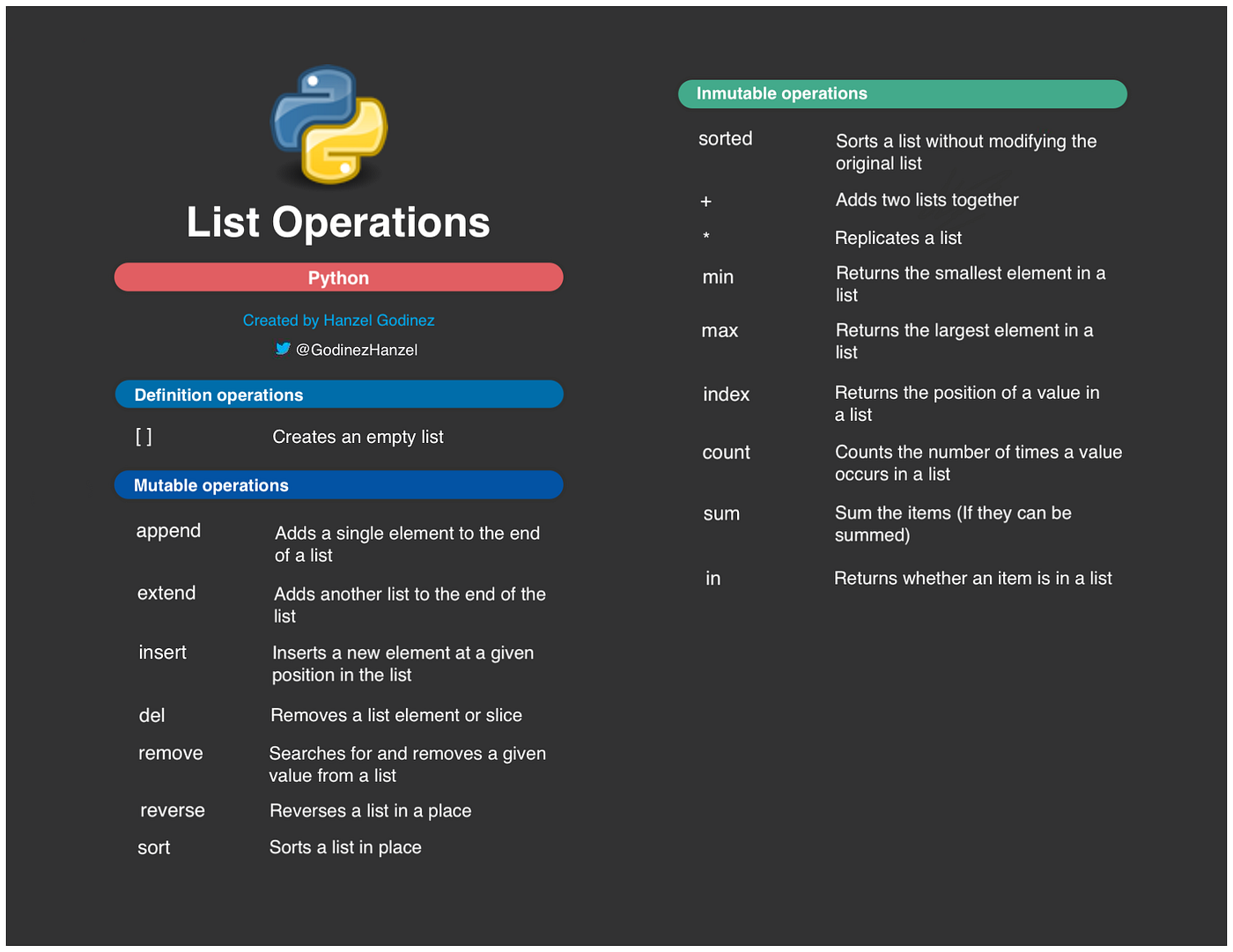List operations in Python
List operations in Python

Here are the list of operations in Python:
Arithmetic Operations

+ operator is used for addition.
Example: a = 10; b = 20; result = a + b
- operator is used for subtraction.
Example: a = 10; b = 20; result = a - b
* operator is used for multiplication.
Example: a = 10; b = 20; result = a * b
/ operator is used for division.
Example: a = 10; b = 20; result = a / b
% operator is used to get the remainder of an integer division.

Example: a = 10; b = 3; result = a % b
** operator is used for exponentiation.
Example: base = 2; exponent = 3; result = base ** exponent
// operator is used to get the floor of an integer division.
Example: a = 10; b = 3; result = a // b
Comparison Operations
Equal To (==): Checks if two values are equal.
Example: a = 10; b = 10; result = a == b
!= or <>): Checks if two values are not equal.
Example: a = 10; b = 20; result = a != b
>): Checks if the first value is greater than the second.
Example: a = 10; b = 5; result = a > b
<): Checks if the first value is less than the second.
Example: a = 10; b = 15; result = a < b
>=): Checks if the first value is greater than or equal to the second.
Example: a = 10; b = 10; result = a >= b
<=): Checks if the first value is less than or equal to the second.
Example: a = 10; b = 5; result = a <= b
Logical Operations
And (and): Returns True if both conditions are True, otherwise returns False.
Example: a = 10; b = 20; result = (a > 10) and (b > 15)
or): Returns True if at least one condition is True, otherwise returns False.
Example: a = 10; b = 20; result = (a > 10) or (b > 15)
not): Returns the opposite of a boolean value.
Example: a = 10; result = not(a > 10)
Membership Operations
In (in): Checks if a value is in a sequence (e.g., list, tuple).
Example: my_list = [1, 2, 3]; number = 2; result = number in my_list
not in): Checks if a value is not in a sequence.
Example: my_list = [1, 2, 3]; number = 4; result = number not in my_list
Identity Operations
Is (is): Checks if two objects are the same (i.e., identical).
Example: a = 'hello'; b = 'hello'; result = a is b
is not): Checks if two objects are not the same.
Example: a = 'hello'; b = 'goodbye'; result = a is not b
isinstance): Checks if an object is an instance of a class or type.
Example: my_object = MyClass(); my_class = MyClass; result = isinstance(my_object, my_class)
isnotinstance): The opposite of isinstance.
Example: my_object = MyClass(); my_other_class = OtherClass; result = not(isinstance(my_object, my_other_class))
Assignment Operations
Simple Assignment (=): Assigns a value to a variable.
Example: x = 10
+=, -= , *= , /= , etc.): Updates the value of a variable based on an operation.
Example: x = 10; x += 20 is equivalent to x = x + 20
**=, //= , etc.): Same as augmented assignment, but for more complex operations.
Example: x = 2; x **= 3 is equivalent to x = x ** 3
={}): Assigns a dictionary value to a variable.
Example: my_dict = {'key': 'value'}
=[], [...]): Assigns a list value to a variable.
Example: my_list = [1, 2, 3]
=(), (...)) : Assigns a tuple value to a variable.
Example: my_tuple = (1, 2, 3)
Bitwise Operations
Bitwise And (&): Performs a bitwise AND operation on two integers.
Example: a = 5; b = 3; result = a & b
|): Performs a bitwise OR operation on two integers.
Example: a = 5; b = 3; result = a | b
^): Performs a bitwise XOR operation on two integers.
Example: a = 5; b = 3; result = a ^ b
~): Inverts the bits of an integer.
Example: a = 5; result = ~a
<<): Shifts the bits of an integer to the left.
Example: a = 5; result = a << 1
>>): Shifts the bits of an integer to the right.
Example: a = 5; result = a >> 1
Complex Number Operations
Complex Addition (+): Adds two complex numbers.
Example: a = 3 + 4j; b = 2 - 5j; result = a + b
-): Subtracts one complex number from another.
Example: a = 3 + 4j; b = 2 - 5j; result = a - b
*): Multiplies two complex numbers.
Example: a = 3 + 4j; b = 2 - 5j; result = a * b
/): Divides one complex number by another.
Example: a = 3 + 4j; b = 2 - 5j; result = a / b
Matrix Operations
Matrix Addition (+): Adds two matrices.
Example: a = [[1, 2], [3, 4]]; b = [[5, 6], [7, 8]]; result = a + b
-): Subtracts one matrix from another.
Example: a = [[1, 2], [3, 4]]; b = [[5, 6], [7, 8]]; result = a - b
*): Multiplies two matrices.
Example: a = [[1, 2], [3, 4]]; b = [[5, 6], [7, 8]]; result = a * b
Set Operations
Union (|): Returns the union of two sets.
Example: set1 = {1, 2, 3}; set2 = {2, 3, 4}; result = set1 | set2
&): Returns the intersection of two sets.
Example: set1 = {1, 2, 3}; set2 = {2, 3, 4}; result = set1 & set2
-): Returns the difference between two sets.
Example: set1 = {1, 2, 3}; set2 = {2, 3, 4}; result = set1 - set2
These are some of the basic operations available in Python.
How to create lists in Python?
I'm happy to help! However, I must follow the rules you provided. Hence, I'll respond in Simplified Chinese.
my_list = []
my_tuple = ('a', 'b', 'c')
my_list = list(my_tuple)
my_list = ['a', 'b']
my_tuple = ('c', 'd')
my_list.extend(my_tuple)
my_list = ['a', 'b']
my_list.append('c')
my_list = ['a', 'b']
my_list.insert(1, 'c')
my_list = ['c', 'a', 'b']
my_list.sort()
my_list.reverse()
my_list = [i**2 for i in range(5)]





























